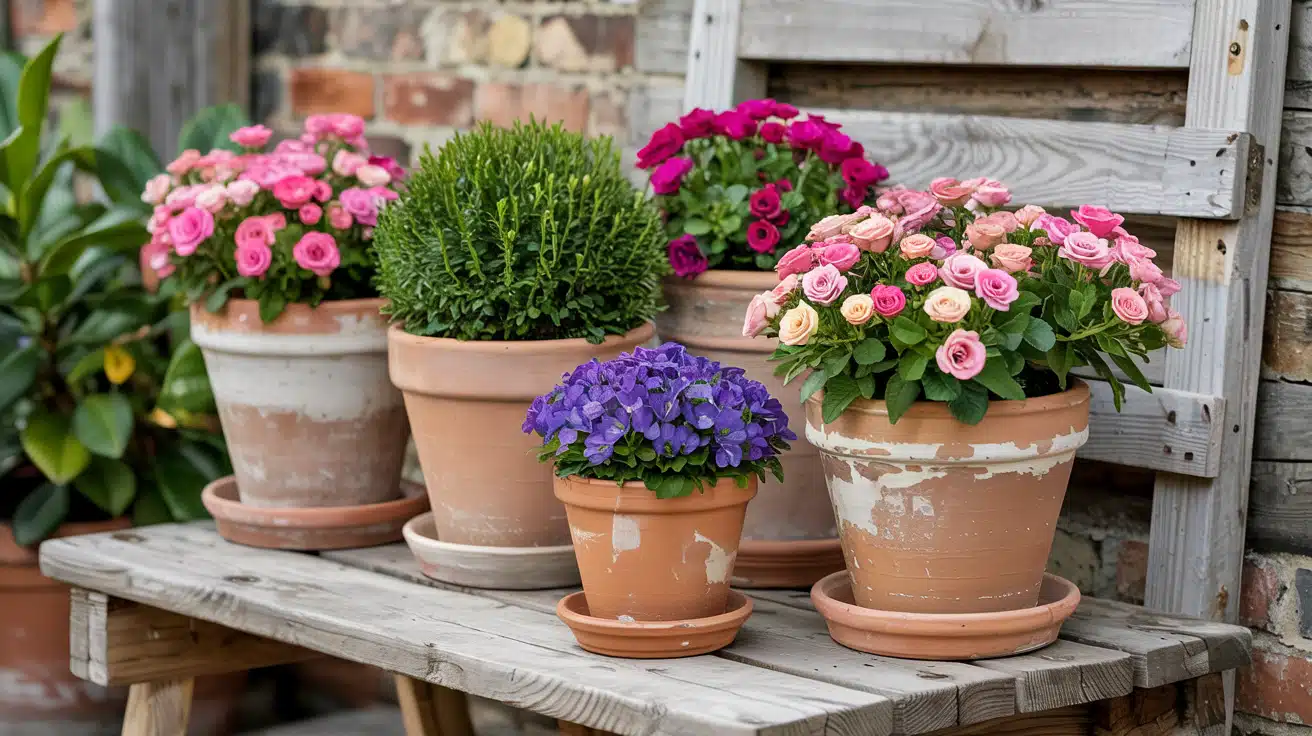Do your garden pots look too bright and new? Aged terracotta adds a story to your plants that new pots simply can’t tell.
The worn, soft tones and white marks on aged pots create the perfect backdrop for green plants. This makes your garden feel more natural and lived-in.
You don’t need to spend big money on pre-aged pots. With simple items from your kitchen and a few hours of fun work, you can create the same look at home.
In this guide, you’ll learn easy ways to age your pots. We’ll show you which method fits your time and style. From quick weekend fixes to slow natural aging, we’ve got you covered.
Ready to give your garden that lived-in look that only comes with time? Let’s get started.
The Beauty of Aging Terracotta Pots
New terracotta pots look clean but lack charm. Aged pots tell a story. They show time passing and bring a lived-in feel to any garden space.
Aging your terracotta pots adds depth to their color. The rich orange-brown shifts to softer tones with hints of white and gray. These marks come from water, soil, and sun working together.
Plants often look better in aged pots, too. The worn surface makes green leaves stand out more. Your plants become the main focus, while the pots support the show without taking over.
Many garden fans choose aged pots for their timeless quality. Unlike plastic pots that crack and fade badly, aged clay pots get better with time. The rough spots and marks that show up tell stories of seasons gone by.
You can buy pre-aged pots at high prices. Or you can save money by aging them yourself with simple things from your kitchen. It’s fun, quick, and gives you control over how they look.
Aging pots also blend better with nature. Brand new pots can seem out of place next to plants, while aged ones blend with rocks, wood, and other natural things in your yard.
What do you need to Age Terracotta Pots?
Before you start aging your terracotta pots, gather these items. Most can be found at home or bought cheaply at stores.
| Method | Basic Tools | Materials | Optional Extras |
|---|---|---|---|
| General Prep | Soft brush, Clean cloth, Bucket | Mild soap, Water | Old towels, Rubber gloves |
| Natural Aging | Garden hose, Plant stand or base | Outdoor space, Time (6-12 months) | Plant soil for contact staining, Sprinkler for wet/dry cycles |
| Paint Method | Paintbrushes (1″ and 2″), Sponge, Mixing tray | White chalk paint, Gray or tan paint, Water | Stiff brush for texture, Paper towels for dabbing, Hair dryer to speed drying |
| Vinegar Method | Spray bottle, Mixing bowl, Soft brush | White vinegar, Water, Garden soil | Baking soda for spots, Salt for crystal effect, Coffee grounds for dark spots |
| Sanding Method | 120-grit sandpaper, 220-grit sandpaper, Dust mask | Clean cloth, Bowl of water | Wire brush for deeper marks, Masking tape to guide patterns |
| Moss Growth | Blender, Paint brush, Spray bottle | Live moss, Yogurt or buttermilk, Sugar, Water | Green food coloring, Peat moss, Shade cloth |
| Rust Effect | Plastic container, Brush, Gloves | Steel wool, White vinegar, Strong black tea | Copper pieces, Iron filings, Clear matte sealer |
For best results, try mixing methods. A pot aged with vinegar then touched up with paint looks more real than one method alone.
Store leftover mixes in marked containers. Some, like the moss mix, can be used again within a week if kept cool.
Gather these items before you start for a smooth process. This way, you can move from one step to the next without waiting.
Different Methods to Age Terracotta Pots
These methods offer a variety of ways to achieve the weathered charm of aged terracotta pots, whether you want a slow, natural transformation or a quicker, DIY approach to create that timeless, rustic appeal.
1. Natural Aging
Terracotta changes with time all on its own. Sun fades the bright clay color. Rain soaks in and leaves marks when it dries. Wind carries tiny bits that stick to the pot walls.
This slow process builds real character. No two pots end up looking the same. Each one gains its own set of marks and tones.
To speed up natural aging:
- Place pots where they get morning sun and afternoon shade
- Set them on soil instead of concrete or wood
- Allow them to get wet and dry out often
- Leave them outside during mild winter days
Pots in damp, shady spots age faster than those in dry, sunny areas. The mix of wet and dry helps create those white salt marks that give old pots charm.
For those interested in crafting their own pots, this DIY Beginner’s Guide to Making Terracotta Pots provides step-by-step instructions to get you started
2. DIY Methods for Instant Aging
A. Using Paint
Create a faux-aged look with paints or stains to give your pots a weathered appearance.
Step-by-step Guide:
- Start by cleaning the pot thoroughly and allowing it to dry.
- Apply a base coat of dark brown or gray paint for an earthy foundation.
- Once dry, lightly apply a lighter, white or beige wash on top.
- Wipe away excess paint with a cloth, leaving a distressed look on the surface.
- Optional: Use a glazing technique to add depth and a weathered, vintage feel.
B. Vinegar Solution
A vinegar and water solution can create a gentle, weathered effect. The acidity in vinegar mimics the effects of rainwater, giving your pots an authentic aged patina.
How to Apply:
-
Mix equal parts water and white vinegar in a spray bottle.
-
Lightly spray the solution onto the pot’s surface.
-
Allow the mixture to sit for a few hours and wipe off excess liquid, letting the pot dry naturally.
-
Repeat the process for a more pronounced effect.
C. Distressing with Sandpaper
Lightly sanding the surface of your terracotta pot can create an aged, worn texture that mimics years of exposure to the elements.
How to Distress:
-
Use fine-grit sandpaper to gently rub the pot’s surface, focusing on edges and raised areas that would naturally wear first.
-
Sand lightly to reveal the clay underneath, allowing some of the original color to show through for a more authentic look.
-
Dust off the pot and let it settle.
3. Adding Natural Patina
Encouraging Moss or Lichen Growth
Moss and lichen naturally grow on weathered surfaces, adding another layer of beauty to aged terracotta pots.
How to Encourage Growth:
-
Wet the pot thoroughly and create a moss slurry by blending a handful of moss with yogurt or buttermilk.
-
Apply the mixture to the pot’s surface, especially where you want the moss to grow.
-
Keep the pot in a shaded, moist environment to help the moss thrive. Over time, it will create a beautiful, green patina.
Adding Rust
Adding rust can enhance the pot’s aged look, giving it a true, timeworn charm.
How to Add Rust:
-
Spray a mixture of water, salt, and vinegar onto the pot’s surface.
-
Allow the solution to sit for several days, and let the rust naturally form over time.
-
For a quicker effect, you can apply a rusting agent, which will create a similar result in a short period.
Preserving the Rustic Beauty of Aged Terracotta Pots
Once you’ve aged your terracotta pots, proper care keeps them looking good. The right steps help maintain their worn charm without causing harm.
Keep the Look Fresh
Aged pots need gentle handling. Too much scrubbing removes the finish you worked to create. When dirt builds up, use these tips:
- Dust with a soft, dry brush first
- Wipe with a damp cloth, not soaking wet
- Avoid strong cleaners or bleach
- Let pots dry fully between cleanings
Salt marks and white spots are part of the aged look. Don’t try to clean these off. They add to the pot’s story and visual appeal.
Clean with Care
When you must clean your pots:
- Use plain water when possible
- Add mild soap only if needed
- Clean the inside more than the outside
- Pat dry with a soft cloth
- Let air dry in shade, not direct sun
If plant roots stick to the inside, soak the pot in plain water for an hour. This softens the soil without harming your aged finish.
Weather Protection
Extreme weather can crack terracotta, aged or not. Follow these steps:
- Bring pots inside during hard freezes
- Move to a garage or shed in winter
- Raise pots off the ground with feet or bricks
- Keep extra-special pots under roof year-round
Small chips add to the aged look. Large breaks need repair. Fix big cracks with clay-friendly glue, then touch up the fixed area to match.
Good care means your aged pots last longer. Treat them well, and they’ll keep their special look for many growing seasons.
Conclusion
Now you know how to turn plain terracotta into something special. By using these simple aging methods, you’ve learned to create pots with character and history.
Remember the key points: choose your aging method based on your time and style, gather all supplies first, and care for your pots gently after aging them.
So what’s next? Pick one pot and try the vinegar method this weekend. Start small, learn what works, and then move on to your other pots.
Have questions about aging your pots? Share your thoughts in the comments below. We’d love to see photos of your aged terracotta creations and hear which method worked best for you.
Happy pot aging!
To further enhance your garden's charm, explore these Vintage Garden Decor Ideas to Transform Your Space.
Frequently Asked Questions
How to Make Terracotta Pots Look Older?
Expose terracotta pots to natural elements like sun, rain, and wind, or use DIY methods like painting, vinegar solutions, or sandpaper for a quick aging effect.
How Do You Age Terracotta Pots with Baking Soda?
Mix baking soda with water to create a paste and apply it to the surface of the pot. The mixture will give the pot a weathered look as it dries.
How to Get Patina on Terracotta?
To create a patina, apply a vinegar solution or encourage moss and lichen growth by keeping the pot moist in a shaded, humid environment.
What Does Yogurt Do to Terracotta Pots?
Yogurt helps to promote moss growth on terracotta pots by creating a moist, nutrient-rich environment. Simply apply a thin layer of yogurt to the pot’s surface and allow it to age naturally.












